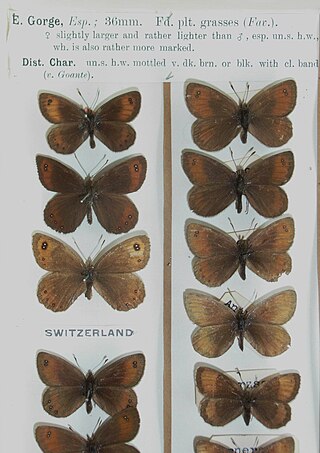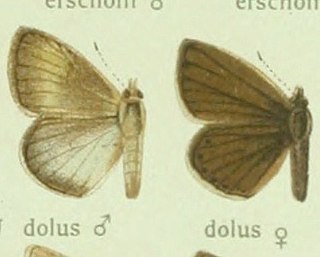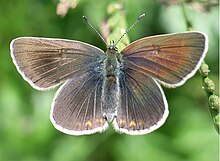
The chalkhill blue is a butterfly in the family Lycaenidae. It is a small butterfly that can be found throughout the Palearctic realm, where it occurs primarily in grasslands rich in chalk. Males have a pale blue colour, while females are brown. Both have chequered fringes around their wings.

The Adonis blue is a butterfly in the family Lycaenidae. It inhabits the Palearctic realm.

The purple-shot copper is a butterfly in the family of the Lycaenidae or copper butterflies and in the genus of the Lycaena.

The scarce copper is a butterfly of the family Lycaenidae.

Polyommatus eros, the Eros blue or common meadow blue, is a species of blue butterfly found in the Palearctic.

Pamiria omphisa, the dusky green underwing, is a species of blue (Lycaenidae) butterfly found in Asia.

The silky ringlet is a member of the subfamily Satyrinae of the family Nymphalidae. It is a high-altitude butterfly found on screes in the Alps, Pyrenees, central Italy and the Balkans. It is a very variable butterfly.

The water ringlet is a member of the subfamily Satyrinae of family Nymphalidae. It is a high altitude butterfly found in the Alps, Bavaria, Styria, Pyrenees, Carpathians and Bulgaria.

Glaucopsyche alexis, the green-underside blue, is a butterfly of the family Lycaenidae. It is found in the Palearctic.

Lycaena helle, the violet copper, is a butterfly of the family Lycaenidae. It is found from the Pyrenees to northern Norway and from Belgium east across the Palearctic to Central Asia, Siberia and Amur.The wingspan is 24–26 mm. The butterfly flies from May to July depending on the location.

Aricia nicias, the silvery argus, is a butterfly of the family Lycaenidae. It is found in the Alps, Pyrenees and from Scandinavia ranging to Siberia and the north of Mongolia.

Pseudophilotes baton, the baton blue, is a butterfly of the family Lycaenidae. It is found in central and southern Europe and then east across the Palearctic to the Russian Far East.

Polyommatus amandus, the Amanda's blue, is a butterfly of the family Lycaenidae. It is found in the Palearctic realm.

Polyommatus damon, the Damon blue, is a butterfly of the family Lycaenidae.

Polyommatus escheri, Escher's blue, is a butterfly of the family Lycaenidae. It is found in Southern Europe and Morocco.

Erebia pandrose, the dewy ringlet, is a member of the subfamily Satyrinae of the family Nymphalidae. It is found from the Arctic areas of northern Europe, the Pyrenees, Alps, the Apennine Mountains, the Carpathian Mountains, Kola Peninsula and Kanin Peninsula, part of the Ural and the Altai and Sayan Mountains up to Mongolia.

Polyommatus dolus, the furry blue, is a butterfly of the family Lycaenidae. It is found in Spain, in France and Italy.

Polyommatus (Plebicula) dorylas, the turquoise blue, is a butterfly of the family Lycaenidae. It is found in southern Europe, Asia Minor, the Ural Mountains, Caucasus and Transcaucasia. Its wingspan is 15–17 mm. The butterfly's common name comes from the dazzling bright blue colour of male's wings. The larvae feed on Anthyllis vulneraria. The butterfly flies from May to September in two generations. Habitats include flowery meadows in rocky areas at 500–2000 m.

Polyommatus admetus, the anomalous blue, is a butterfly of the family Lycaenidae. It was described by Eugenius Johann Christoph Esper in 1783. It is found in south-eastern Europe and Turkey.

Polyommatus damone is a Palearctic butterfly in the Lycaenidae family.






















